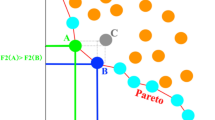Abstract
We consider multiobjective optimization problems affected by uncertainty, where the objective functions or the restrictions involve random variables. We are interested in the evaluation of statistics such as medians, quantiles and confidence intervals for the Pareto front. We present a method for the determination of such statistics which is independent of the representation used to describe the Pareto front. In a second step, we start from a sample of Pareto fronts and we use a Generalized Fourier Series approach to generate a larger sample of about 105 Pareto fronts with a reasonable computational cost. These large samples are used to obtain more accurate statistics. Examples show that the method is effective to calculate.
Access this chapter
Tax calculation will be finalised at checkout
Purchases are for personal use only
Similar content being viewed by others
References
Croquet, R., Souza de Cursi, E.: Statistics of uncertain dynamical systems. In: Topping, B.H.V., Adam, J.M., Pallarés, F.J., Bru, R., Romero, M.L. (eds.) Proceedings of the Tenth International Conference on Computational Structures Technology, Paper 173, Civil-Comp Press, Stirlingshire, UK (93), pp. 541–561. https://doi.org/10.4203/ccp.93.173 (2010)
Bassi, M., Souza de Cursi, E., Ellaia, R.: Generalized fourier series for representing random variables and application for quantifying uncertainties in optimization. In: 3rd International Symposium on Uncertainty Quantification and Stochastic Modeling, Maresias, SP, Brazil, 15–19 February (2016). http://www.swge.inf.br/PDF/USM-2016-0037_027656.PDF
Bassi, M.: Quantification d’Incertitudes et Objets en Dimension Infinie. Ph.D. Thesis, INSA Rouen Normandie, Normandie Université, Saint-Etienne du Rouvray (2019)
Souza de Cursi, E., Sampaio, R.: Uncertainty Quantification and Stochastic Modelling with Matlab. ISTE Press, London, UK (2015)
Bassi, M., Souza de Cursi, E., Pagnacco, E., Ellaia, R.: Statistics of the pareto front in multi-objective optimization under uncertainties. Lat. Am. J. Solids Struct. 15(11), e130. Epub November 14, 2018. https://doi.org/10.1590/1679-78255018 (2018)
Dubuisson, M., Jain, A.K.: A modified hausdorff distance for object matching. In: Proceedings of 12th International Conference on Pattern Recognition, October 9–13, Jerusalem, pp. 566–568, https://doi.org/10.1109/icpr.1994.576361 (1994)
Author information
Authors and Affiliations
Corresponding author
Editor information
Editors and Affiliations
Appendix A: Generalized Fourier Series
Appendix A: Generalized Fourier Series
In the framework of UQ, we are interested in the representation of random variables: let us consider a couple of random variables \( \left( {\varvec{U},\varvec{X}} \right) \), such that \( \varvec{X} = \varvec{X}\left( \varvec{U} \right) \), that is \( \varvec{X} \) is a function of \( \varvec{U} \). If \( \varvec{X} \in V \), where \( V \) is a separable Hilbert space, associated to the scalar product \( \left( { \bullet , \bullet } \right) \), we may consider a convenient Hilbert basis (or total family) \( \Phi = \left\{ {\varphi_{i} } \right\}_{{i \in {\mathbb{N}}}} \) and look for a representation \( \varvec{X} \) given by [2]:
If the family is orthonormal, \( \left( {\varphi_{i} , \varphi_{j} } \right) = \delta_{ij} \) and the coefficients of the expansion are given by \( \varvec{x}_{\varvec{i}} = \left( {\varvec{X},\varphi_{i} \left( \varvec{U} \right)} \right) \). Otherwise, we may consider the approximations of \( \varvec{X} \) by finite sums:
In this case, the coefficients \( \varvec{x}_{\varvec{i}} \) are the solutions of the linear system \( {\mathbf{\mathcal{A}}}\varvec{x} = {\mathbf{\mathcal{B}}} \), where \( {\mathbf{\mathcal{A}}}_{{\varvec{ij}}} = \left( {\varphi_{i} , \varphi_{j} } \right) \) and \( {\mathbf{\mathcal{B}}}_{\varvec{i}} = \left( {\varvec{X}, \varphi_{i} } \right) \). We have:
In UQ, the Hilbert space \( V \) is mainly \( L^{2} \left( {\Omega ,P} \right) \), where \( \Omega \subset {\mathbb{R}}^{n} \) and \( P \) is a probability measure, with \( \varvec{ }\left( {\varvec{Y},\varvec{Z}} \right) = {\text{E}}\left( {\varvec{YZ}} \right) \). Classical families \( \Phi \) are formed by polynomials, trigonometric functions, Splines or Finite Elements approximations. Examples of approximations may be found in the literature (see, for instance, [2, 3]). When X is a function of a second variable – for instance, t – we denote the function \( \varvec{X}\left( {t |\varvec{U}} \right) \) and we have:
The reader may refer to [4] to get more information and MATLAB codes for the evaluation of the coefficients \( \varvec{x}_{\varvec{i}} \), namely in multidimensional situations. In practice, we use a sample from \( \left( {t |\varvec{U}} \right)\,:\varvec{X}\left( {t |\varvec{U}_{1} } \right), \ldots ,\varvec{X}\left( {t |\varvec{U}_{{\varvec{ns}}} } \right) \) in order to evaluate the means forming \( {\mathbf{\mathcal{A}}} \) and \( {\mathbf{\mathcal{B}}} \).
Rights and permissions
Copyright information
© 2020 Springer Nature Switzerland AG
About this paper
Cite this paper
Bassi, M., Pagnacco, E., de Cursi, E.S., Ellaia, R. (2020). Statistics of Pareto Fronts. In: Le Thi, H., Le, H., Pham Dinh, T. (eds) Optimization of Complex Systems: Theory, Models, Algorithms and Applications. WCGO 2019. Advances in Intelligent Systems and Computing, vol 991. Springer, Cham. https://doi.org/10.1007/978-3-030-21803-4_55
Download citation
DOI: https://doi.org/10.1007/978-3-030-21803-4_55
Published:
Publisher Name: Springer, Cham
Print ISBN: 978-3-030-21802-7
Online ISBN: 978-3-030-21803-4
eBook Packages: Intelligent Technologies and RoboticsIntelligent Technologies and Robotics (R0)




